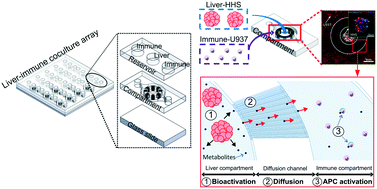A liver-immune coculture array for predicting systemic drug-induced skin sensitization†
Abstract
Drug-induced skin sensitization is prevalent worldwide and can trigger life-threatening health conditions, such as Stevens Johnson Syndrome. However, existing in vitro skin models cannot adequately predict the skin sensitization effects of drugs administered into the systemic circulation because dermal inflammation and injury are preceded by conversion of parent drugs into antigenic reactive metabolites in the liver and subsequent activation of the immune system. Here, we demonstrate that recapitulation of these early tandem cellular processes in a compartmentalized liver-immune coculture array is sufficient to predict the skin sensitization potential of systemic drugs. Human progenitor cell (HepaRG)-derived hepatocyte spheroids and U937 myeloid cells, a representative antigen presenting cell (APC), can maintain their respective functions in 2 concentric micro-chambers, which are connected by a diffusion microchannel network. Paradigm drugs that are reported to cause severe cutaneous drug reactions (i.e. carbamazepine, phenytoin and allopurinol) can be metabolized into their reactive metabolites, which diffuse efficiently into the adjoining immune compartment within a 48 hour period. By measuring the extent of U937 activation as indicated by IL8, IL1β and CD86 upregulation upon drug administration, we show that the liver-immune coculture array more consistently and reliably distinguish all 3-paradigm skin sensitizing drugs from a non-skin sensitizer than conventional bulk Transwell coculture. Given its miniaturized format, design simplicity and prediction capability, this novel in vitro system can be readily scaled into a screenable platform to identify the skin sensitization potential of systemically-administered drugs.

- This article is part of the themed collection: Lab on a Chip Emerging Investigators


 Please wait while we load your content...
Please wait while we load your content...